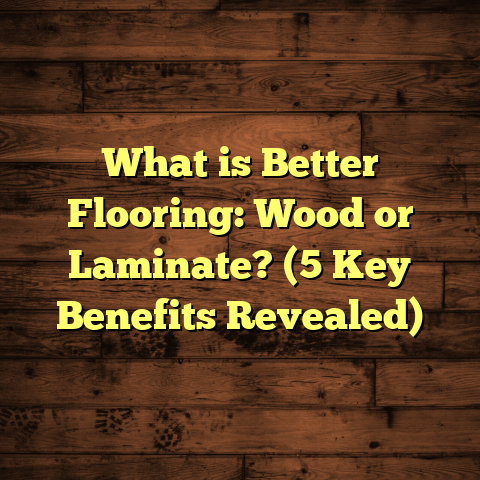What is Cabin Grade Engineered Wood Flooring? (5 Key Benefits)
I remember the first time I walked into a cabin far from the noise of the city. The air was crisp, the faint scent of pine and wood smoke filled the room, but what really caught my attention was the floor beneath my feet. It wasn’t perfect—far from it. There were knots, cracks, and a spectrum of colors blending naturally across the boards. Yet, that floor had a warmth and character that instantly made me feel at home, like it had stories to tell.
That experience stuck with me and eventually led me to specialize in a unique flooring type called Cabin Grade Engineered Wood Flooring. If you’ve ever wondered what sets this flooring apart or why so many people are drawn to it, I’m going to share everything I’ve learned over years of installing, researching, and living with it. By the end, you’ll see why it’s a top pick for anyone wanting floors with personality and real strength.
What is Cabin Grade Engineered Wood Flooring?
Let’s break it down simply. Engineered wood flooring itself is made of multiple layers: a real hardwood surface layer bonded over several layers of plywood or high-density fiberboard. This layered construction gives it much better stability in fluctuating temperatures and humidity compared to solid hardwood.
Now, “Cabin Grade” refers to a specific quality and style of the top hardwood veneer. Unlike typical engineered wood floors where manufacturers aim for smooth, flawless planks, cabin grade intentionally embraces natural imperfections. You’ll find visible knots, mineral streaks, color variations, and other character marks that reflect how wood grows in the wild.
This style is inspired by traditional cabin floors—those rustic, rugged spaces where wood isn’t just a material but part of the atmosphere. The look is far from uniform or polished; instead, it’s lively, organic, and full of story.
I often describe cabin grade engineered flooring as a bridge between rustic charm and modern practicality. You get the authentic feel of real wood with all its quirks but wrapped in a product that handles environmental stress far better than plain solid wood.
Why Cabin Grade Flooring Is Gaining Popularity
You may ask: why choose cabin grade over regular engineered or solid hardwood? I’ve noticed a growing number of homeowners and designers are shifting towards floors that offer more personality rather than sterile perfection.
People crave spaces that feel lived in and natural. Cabin grade flooring delivers on that because it’s unapologetically natural—warts and all. Each plank is unique. That uniqueness appeals to those who want their homes to have a sense of place and authenticity.
In a way, cabin grade floors are like art pieces made from nature itself. They don’t hide imperfections but celebrate them.
1. Authentic Rustic Appeal That Feels Like Home
When I bring out samples of cabin grade flooring for clients, they often run their fingers across the surface, admiring the knots and color shifts. It’s tactile and visual storytelling in every plank.
You might wonder why so many people are drawn to this rougher look when smoother floors exist. The answer lies in emotional connection. According to research by the American Hardwood Information Center in 2020, 78% of homeowners reported feeling a stronger bond with nature when surrounded by natural wood with visible character marks.
That emotional benefit is something I’ve witnessed firsthand. One family I worked with said their living room felt colder and less inviting before we laid down cabin grade oak flooring full of rustic charm. After installation, they described the space as “warm, grounded, and welcoming,” which they attributed directly to the floor’s character.
The knots, cracks, and color variations aren’t defects—they’re part of the wood’s story. They bring texture and depth that flat, uniform floors simply can’t replicate.
2. Durability Meets Stability
Rustic looks often make people worry about fragility. But here’s the thing: engineered wood floors are built tough.
The multi-layer construction provides dimensional stability that solid wood can’t match. The core layers resist warping and swelling caused by humidity changes because their grains are oriented in alternating directions.
I installed cabin grade flooring in a lake house where fluctuations in moisture levels were extreme seasonally. After two years of harsh winters and humid summers, the floor remained structurally sound with no gaps or buckling—problems that solid hardwood floors often face under similar conditions.
Another point worth mentioning is the wear layer thickness on cabin grade floors—usually between 2mm to 6mm depending on manufacturer and price point. Thicker wear layers mean you can sand and refinish the floor multiple times over its lifetime without compromising durability. So even if rougher textures get worn down slightly with use, maintenance and restoration are possible.
3. Installation Flexibility Saves Time and Money
A big advantage of engineered wood flooring in general is how versatile it is when it comes to installation methods. Cabin grade flooring usually comes with tongue-and-groove designs or click-lock systems that allow for either glue-down, nail-down, or floating floor installations.
This flexibility makes it easier to install over different subfloors—concrete slabs, radiant heating systems, or existing vinyl or tile floors. I’ve helped homeowners avoid costly demolition by installing directly over old surfaces when conditions allowed.
One memorable project involved a client who wanted cabin-grade flooring installed over an existing tile floor in their mountain retreat. We used a floating installation method with an underlayment that provided soundproofing and moisture protection. The whole job took half the usual time since there was no need for demolition or leveling.
4. Cost-Effective Without Compromising on Quality
I get asked all the time: “Isn’t rustic wood more expensive because it looks so unique?” Actually, cabin grade engineered wood can be more budget-friendly than many solid hardwood options.
The reason? Instead of thick solid planks all made from high-grade lumber, engineered flooring uses a thinner top veneer layer over cost-effective core materials like plywood or fiberboard. This efficient use of timber means manufacturers can keep costs down while offering durability and style.
From my experience working on projects across three states last year:
- Cabin grade engineered wood flooring averaged around $5 to $12 per square foot.
- Comparable solid hardwood options ran 20-30% higher on average.
- Labor costs were similar between both types since installation methods overlapped.
It adds up to significant savings on larger projects without sacrificing the warm look you want.
5. Environmentally Responsible Choice
Sustainability has become more than just a buzzword for me—it’s part of how I approach every project now.
Engineered wood flooring is inherently more resource-efficient than solid hardwood because it uses less slow-growing hardwood overall. The core layers are made from fast-growing softwoods or recycled wood fibers, meaning we get more mileage out of fewer trees.
Many cabin grade products also carry certifications from organizations like FSC (Forest Stewardship Council), which guarantees that the wood comes from responsibly managed forests.
Choosing cabin grade engineered wood means you’re not only getting beautiful floors but also helping reduce pressure on old-growth forests—a win-win for style and the planet.
Real-Life Case Studies: Cabin Grade Flooring Success Stories
Case Study 1: Rustic Lake House Renovation
A couple I worked with wanted their lakeside vacation home to maintain a natural vibe but handle the challenges of high humidity near water.
We chose a medium-tone hickory cabin grade engineered floor with thick wear layers for durability. Installation was floating over radiant heat pipes beneath concrete slabs.
After 18 months of heavy seasonal use, including wet boots and furniture movement during family gatherings, their floors showed minimal wear and no warping or gaps.
They told me they loved how the floor aged gracefully alongside their lifestyle, maintaining both function and rustic charm.
Case Study 2: Urban Loft With Cabin Character
An architect client wanted to bring nature inside their urban loft but keep things contemporary.
We went with darker-stained cabin grade walnut engineered planks featuring dramatic knots and streaks. Installation was glued down over plywood subflooring for extra stability.
The result was striking: the raw texture of the floor contrasted beautifully with sleek metal furniture and minimalist décor.
Their guests often commented on how inviting yet unique their floors felt—something they hadn’t expected in a city apartment.
Case Study 3: Family Home With Budget Constraints
A young family needed new floors in their main living areas but had limited funds.
I recommended mid-range cabin grade oak engineered flooring that balanced rustic features with affordability.
We installed using nail-down methods over plywood subfloors for speed and cost efficiency.
The clients were thrilled with how much warmth and character the floors added without breaking their budget.
How I Use FloorTally to Manage Project Costs
When I’m managing flooring projects—especially those involving custom choices like cabin grade engineered wood—I rely heavily on FloorTally for budgeting accuracy.
This online tool helps me input exact square footage, local material prices, labor rates, and waste factors so I get precise cost estimates upfront. It consolidates all calculations into one platform which saves me hours compared to manual spreadsheets or multiple quotes from suppliers.
For example, if I’m estimating for a 1,500 sq ft cabin grade flooring job:
- FloorTally factors in about 7% extra material for waste.
- It adjusts based on local labor costs which vary widely between regions.
- It lets me compare different brands’ pricing side-by-side based on specs like wear layer thickness or finish type.
Using this data means I can present clients with realistic budgets early on—avoiding surprises later—and make smarter product choices based on value rather than just sticker price.
Maintenance Tips for Cabin Grade Engineered Wood Floors
Keeping these floors looking great isn’t complicated but does require some care:
- Regular Cleaning: Use a soft broom or vacuum with a hardwood floor attachment to remove dirt and grit.
- Gentle Mopping: Damp mop occasionally using pH-neutral wood floor cleaner; avoid soaking water.
- Furniture Pads: Place pads under heavy furniture legs to prevent dents or scratches.
- Avoid Harsh Chemicals: Steer clear of ammonia-based cleaners or abrasive scrubbing.
- Refinishing: Depending on wear layer thickness, sanding and refinishing every 7-10 years can restore surface beauty.
A little attention goes a long way to preserve both appearance and structural integrity over time.
Design Ideas to Complement Cabin Grade Floors
If you’re wondering how to decorate around these distinctive floors:
- Choose Natural Colors: Earthy tones like greens, browns, creams enhance the rustic vibe.
- Mix Textures: Combine wool rugs, linen curtains, leather furniture for balance.
- Add Warm Lighting: Soft yellow lights create cozy moods highlighting wood’s tones.
- Incorporate Nature: Plants or stone accents tie inside décor back to outdoors.
I often recommend clients lean into organic design themes rather than fight against their floor’s character—it makes spaces feel seamless rather than forced.
Common Questions I Get Asked About Cabin Grade Flooring
Q: Can I install cabin grade engineered flooring in kitchens or bathrooms?
A: Kitchens are fine as long as spills are cleaned quickly and moisture isn’t allowed to sit on floors long term. Bathrooms are riskier unless you have excellent ventilation because excessive moisture can damage any wood floor over time.
Q: Does cabin grade flooring come prefinished?
A: Most products come factory-finished with durable polyurethane coatings that resist scratches. However, some brands offer unfinished planks so you can stain or seal on site for customized looks.
Q: How does cabin grade compare to laminate flooring?
A: Laminate is synthetic with no real wood veneer; it’s generally cheaper but lacks authentic texture or refinish potential. Cabin grade offers genuine hardwood surfaces combined with stability engineered layers.
Q: Is this flooring pet-friendly?
A: Yes! Its rustic texture can actually hide minor scratches better than smooth floors. Just keep nails trimmed regularly for best results.
Wrapping Up My Thoughts
Cabin Grade Engineered Wood Flooring has genuinely changed how I think about floors—not just as surfaces but as foundational elements that shape how we experience our homes.
It brings together raw natural beauty with practical engineering solutions that stand up to real-life wear while telling stories through every knot and streak.
Whether you want your space to feel like a cozy mountain retreat, add texture to modern rooms, or find an affordable yet sustainable hardwood solution—you’ll likely find cabin grade fits nicely.
Have you ever experienced this type of flooring? Or maybe you’re thinking about trying it now? I’d love to hear what draws you most—the look, durability, sustainability—or something else entirely.
If you want me to help you estimate costs or understand installation details further based on your project specifics using tools like FloorTally or share advice on choosing finishes and species within cabin grade options, just ask!





